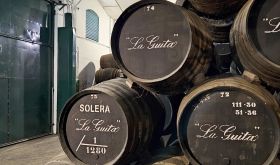From €13.90, £14.95
Yes, yet another South African white as a wine of the week. And why not when this combination of place and colour offers such superb value? This particular wine has a bit of bottle age on it too – despite the relatively low price.
Springfontein is an especially interesting and distinctive wine estate in the far south east of South African wine country. In the Walker Bay district, it’s up a long track from Stanford, quite a way east of Hermanus, the coastal resort that is the centre of the district that was, until the effects of global warming, so famous for whale watching in the Atlantic.
The German owners are unusually generous with information. On the label we’re told that the wine was grown on limestone (‘calcified sand dunes’, according to the tech spec) on a site just 5 km (3 miles) from the Atlantic, and therefore one that presumably benefits from all those cold currents from the south pole and winds from the ocean*. Again I am indebted to the tech spec sheet that tells me the vineyard is just 6 m above sea level and that the fruit was picked on 6 March at an average yield of ’29.6 hl/ha’. On the tech sheet we are even told that the 15-year-old Chenin vines, on Ramsey rootstock, are trained on a five-wire trellis with ‘vertical shoot positioning, double lengthen (Perold system)’. A good 70% of the wine, sufficient to fill 3,500 bottles, was aged in second-fill French barriques, the rest in tank.
So that’s the technical background but what of the wine? I came across it when tasting a range of wines from Private Cellar, the lively fine-wine company with their main office in Cambridgeshire but representatives stationed at various strategic addresses all over the English countryside. Most of the key staff worked for smart traditional merchants, notably Corney & Barrow, in the past. Head buyer is the fastest talker in the wine trade Nicola Arcedeckne-Butler MW.
I will be publishing my notes on the 17 wines I tasted recently with Nicola and her marketing colleague Laura Taylor in due course. They include four wines I marked GV for good value plus this one I thought was VVGV. To find a white as tense and complex as this at coming up for four years old at under £15 a bottle strikes me as uncommon – or at least uncommon in any country other than South Africa.
I loved the light, appetising, slightly salty overlay on fruit that was so massively ripe that it almost tasted botrytised. And then, as is usually the case with South African whites, there was quite enough acidity. Stat fiends may like to know that alcohol is 14.52% (but the wine certainly isn’t heavy); pH is 3.49; total acidity 5.3 g/l; residual sugar 2.5 g/l (it’s rich but not sweet); and total extract is 20.7 g/l.
For what it’s worth, I gave it 17 points out of 20 and imagined it would drink well in the 2014-19 window but I see it wasn’t even bottled until early 2015. Winemaker is Tariro Masayiti, who is the chief spokesperson for the new Stanford Wine Route, according to the bible Platter’s South African Wine Guide, which tells me that the estate has a restaurant and accommodation. As you can see from its website, whence comes this picture, Springfontein produce a bewildering number of ranges and wines, including a rather luscious and hugely distinctive 15%-alcohol Pinotage with 15% Petit Verdot in the mix. You can read my tasting notes on Springfontein wines tasted on my last visit to South Africa, early in 2015, in South African excitement – reds and South African excitement – the rest.
According to wine-searcher.com, the wine is available from a number of outlets in Germany (perhaps not surprising because of the owners Johst and Jen Weber’s nationality), but the following is a list of Springfontein’s importers:
England – Private Cellar
Scotland – Inverarity/Forth Wines
USA – Paul Chartrand, Rockland, Maine (the oldest organic and biodynamic wine importer in the US, according to Springfontein)
Canada – Churchill Cellars, Ontario
Germany – Rebhof Weinhandel GmbH, Essen & Segnitz Weinimport, Bremen
France, Belgium and Luxembourg – Gustoworld (Christophe Heynen)
Switzerland – Jeggli Weine, Zurich
Netherlands – ‘We are just starting a cooperation with Robert Benier of Benier Global Wines. Up to now we have done the sales ourselves and have a number of one- and two-starred Michelin restaurants who take our wines.’
La Réunion – Les Vandanges, La Montagne, Isle de La Réunion
Dubai – MBM
Take advantage of the value for a wine that could be enjoyed without food but has quite enough nerve and substance to stand up to a wide variety of foods. It would certainly spice up a roast chicken.
* 22 January But see this interesting observation just in from Robert White, Emeritus Professor of Soil Science, advisor to the AWRI (and contributor to The Oxford Companion to Wine) no less: 'I read your article on the Chenin Blanc from Springfontein Estate and I located the vineyard on Google Earth. It used to be that one could stand on Cape Point and see where the warm waters of the Agulhas current flowing from the east met the cold waters flowing up from the south to pass up the west coast of South Africa. However, if one looks at current maps of ocean currents around South Africa one sees that the warm waters of the Agulhas current dominate the southern coastline of that country. So Springfontein estate is more likely to be influenced by the warm Agulhas current than anything else at the present time. Have these currents changed over the past 50 years? Perhaps they have due to climate change? Perhaps this warming effect is good for the grapes which do seem to have very high sugar content when ripe. Just a thought.'














